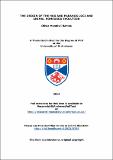Files in this item
The origin of the Hox and ParaHox loci and animal homeobox evolution
Item metadata
| dc.contributor.advisor | Barker, Daniel | |
| dc.contributor.author | Mendivil Ramos, Olivia | |
| dc.coverage.spatial | 243 | en_US |
| dc.date.accessioned | 2015-03-27T17:05:57Z | |
| dc.date.available | 2015-03-27T17:05:57Z | |
| dc.date.issued | 2013-06-25 | |
| dc.identifier | uk.bl.ethos.644802 | en_US |
| dc.identifier.uri | https://hdl.handle.net/10023/6395 | |
| dc.description.abstract | The homeobox superfamily is one of the most significant gene families in the evolution of developmental processes in animals. Within this superfamily the ANTP class has expanded exclusively in animals and, therefore, the reconstruction of its origin and diversification into the different ‘modern’ families have become prominent questions in the ‘evo-devo’ field. The current burgeoning availability of animal genome sequences is improving the resolution of these questions, putting them in a genome evolution context, as well as providing the field with a large, detailed and diverse catalogue of animal homeobox complements. Here I have contributed with a new hypothesis on the origin and evolution of the Hox and ParaHox loci and the new term, ghost loci, referring to homologous genome regions that have lost their homeobox genes. This hypothesis proposes that the last common ancestor of all animals had a much more complex genome (i.e. differentiated Hox, ParaHox and NK loci) that underwent a simplification in the early animal lineages of sponges and placozoans. In collaboration with the Adamska group I resolved the orthology of the first ever ParaHox genes reported in calcareous sponges. This finding serves as an independent confirmation of the ghost loci hypothesis and further resolves the events of secondary simplification within the sponge lineage. Finally, I have catalogued the homeobox complement of the newly sequenced arthropod, the myriapod Strigamia maritima, and examined the linkage and clustering of these genes. This has furthered our understanding of the evolution of the ANTP class. The diversity of the homeobox complement and the retention in this myriapod and the retention of some homeobox genes not previously described within arthropods, in combination with the interesting phylogenetic position that this lineage occupies relative to other arthropods, makes this complement an important point of reference for comparison within the arthropods and in a broader perspective in the ecdyzosoans. These findings have provided significant further insights into the origin and evolution of the homeobox superfamily, with important implications for animal evolution and the evolution of development. | en_US |
| dc.language.iso | en | en_US |
| dc.publisher | University of St Andrews | |
| dc.subject | Evo-devo | en_US |
| dc.subject | Genomics | en_US |
| dc.subject | Sequence evolution | en_US |
| dc.subject.lcc | QH447.8H65M4 | |
| dc.subject.lcsh | Homeobox genes | en_US |
| dc.subject.lcsh | Evolutionary developmental biology | en_US |
| dc.subject.lcsh | Genomics | en_US |
| dc.title | The origin of the Hox and ParaHox loci and animal homeobox evolution | en_US |
| dc.type | Thesis | en_US |
| dc.contributor.sponsor | Biotechnology and Biological Sciences Research Council (BBSRC) | en_US |
| dc.type.qualificationlevel | Doctoral | en_US |
| dc.type.qualificationname | PhD Doctor of Philosophy | en_US |
| dc.publisher.institution | The University of St Andrews | en_US |
| dc.publisher.department | The Scottish Oceans Institute | en_US |
This item appears in the following Collection(s)
Items in the St Andrews Research Repository are protected by copyright, with all rights reserved, unless otherwise indicated.

